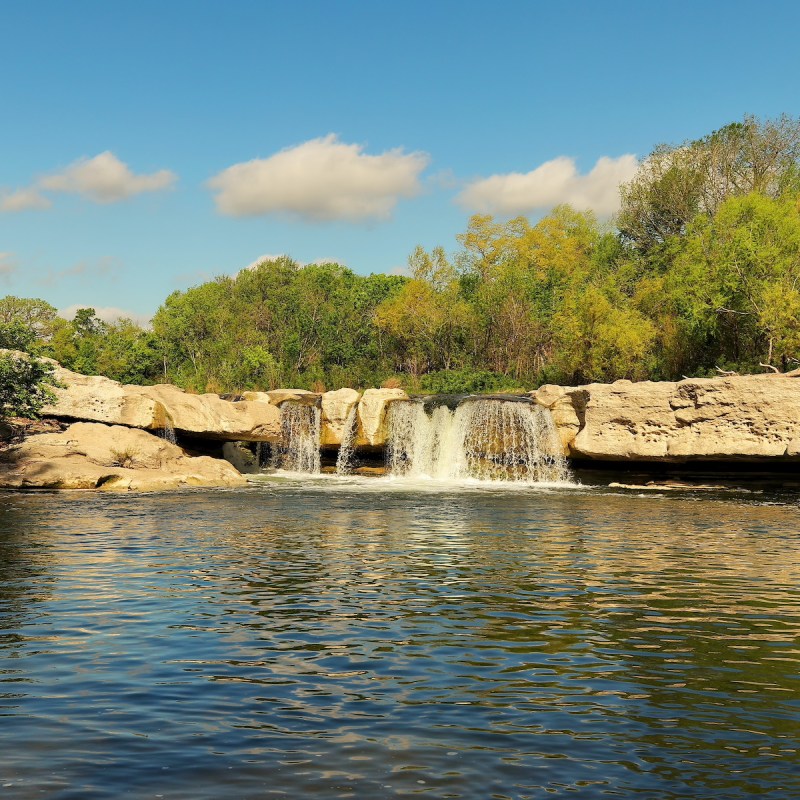
(Hundley Photography / Shutterstock.com)
Camping during weekends has been my favorite tactic to find tranquility after a hectic work week. For 30 years, my protection from the elements was a tent — until one night when my dog Tipper decided the raccoon sniffing around our campsite just had to go. Trying to hold her back as she ripped through the tent was an eye opener, even in the middle of the night. Soon after, we purchased a small 16-foot camper trailer.
Videos by TravelAwaits
My home state of Texas has an amazingly diverse array of beautiful parks scattered throughout. A person can wake up in a dry desert of mesquite trees and sage bushes in the west, red rock canyons in the northern panhandle, or ocean views on the southern coast. They can end the day with rivers and valleys full of wildflowers in the bullseye center or a dense forest mingled with bayous and alligators in the east.
Celebrating my 70th birthday this year, I usually take care to choose parks with accessible features. These are my favorite Texas state parks for scenic views, interesting historic stories, and fun outdoor activities perfect for safely enjoying my home away from home.

(Photo Credit: Ann Bush)
1. Palo Duro Canyon State Park
Canyon
Formed millions of years ago by the Red River, water erosion shaped the canyon’s dramatic steep mesa walls and geological formations of multicolored layers of rock. Twenty miles wide and 800 feet tall, the canyon’s rugged beauty meanders for 120 miles, qualifying as the second largest canyon system in the United States. The top layer of hoodoos is where fossils of saber-toothed cats and long-necked camels have been found.
Located in the Panhandle, an outdoor musical titled TEXAS is held every summer, featuring more than 60 actors, singers, dancers, and horses.
Pro Tip: There is little shade on the high canyon trails, so bring plenty of water. The trails that follow the riverbed are shaded but have rocky areas requiring good hiking shoes. Don’t miss the Interpretive Museum in the visitor center.

(Photo Credit: Ann Bush)
2. Caddo Lake State Park
Karnack
Located 5 miles from the Louisiana border, Caddo Lake State Park offers serene views of graceful white egrets fishing in a slow-moving bayou full of cypress trees dripping with moss. This grand maze of small lakes entangled by bayous draws kayakers from around the U.S.
The depth of the Big Cypress Bayou is between 8 and 20 feet and never has strong currents to wash away the bounty of the forest. The slowness of the flow results in the water becoming dark with nutrients, inviting a zillion insects and fish that draw thousands of water birds and fishing enthusiasts.
Pro Tip: Go early spring or late fall to avoid the rush of mosquitoes. Fall is the most beautiful time to visit, when the bald cypress trees turn burnt-orange.

(Photo Credit: Ann Bush)
3. Huntsville State Park
Huntsville
Southern Texas hosts a park with majestic 100-year-old trees, 21 hiking trails, a bird blind, and a nature center. Another good feature of Huntsville State Park is the surrounding area’s attractions such as the Sam Houston Memorial Museum and the historic Texas State Penitentiary which gives tours. Located in the Sam Houston National Forest, the famous Lone Star Hiking Trail, a 129-mile National Recreation Trail, can be accessed in Huntsville State Park.
Pro Tip: This park is near a major freeway and popular with RVers, so reserve campsites early.

(Photo Credit: Ann Bush)
4. Cooper Lake State Park
Sulphur Springs
Between Dallas and Oklahoma, in cowboy country, is Cooper Lake State Park, where horses rule. Divided into two units by the dam, the Buggy Whip Equestrian Trail crosses nearly 600 acres in the Sulphur Unit. Near the trailhead are campsites that accommodate horse trailers complete with horse-tie bars for resting between rides.
Campsites are large with pull-through driveways since many campers bring boats. There is a place perfect for stargazing because there are no towns close by to light up the sky. Most of the campsites have views of the lake with spectacular sunrises and sunsets.
Pro Tip: The park is isolated, so pack a cooler before leaving the nearest town.

(Photo Credit: Ann Bush)
5. San Angelo State Park
San Angelo
One of the best kept secrets in West Texas is the San Angelo State Park. It’s bordering on the O.C. Fisher Reservoir results in unpredicted vistas and the perfect habitat to support a wide diversity of rangeland wildlife and wildflowers spread over 7,000 acres.
The shy greater roadrunner and armadillo — the state mammal of Texas — are often seen here, plus the park protects the endangered horned lizard species. Unexpected features of the park include petroglyphs, prehistoric animal tracks dated from 250 million years ago, a mastodon fossil site, and a mysterious 1847 grave.
Pro Tip: There are few large trees in West Texas, so be prepared to create your own shade. When it gets too hot, there are lots of cool things to do in the neighboring town of San Angelo.

(Stanley Ford / Shutterstock.com)
6. Dinosaur Valley State Park
Glen Rose
It’s not every day a person can go camping, enjoy a hike along a beautiful river, and step inside a dinosaur track frozen in an ancient seabed. The Dinosaur Valley State Park, a National Natural Landmark near the lively town of Glen Rose, has a well-traveled trail where dinosaurs left their footprints in the soft mud 113 million years ago.
Scientists have identified the three-toed tracks as the Sauroposeidon species, a dinosaur weighing as much as 20 tons and stretching to 70 feet in length. Using their 26-foot-long necks to reach food, they were harmless plant eaters. Both of my feet slid nicely into the deep footprint they left behind — a simple gravestone to prove their existence.
Pro Tip: The trail is occasionally on top of uneven rock and a trekking pole is recommended. Historic downtown Glen Rose has great restaurants.

(Photo Credit: Ann Bush)
7. Sea Rim State Park
Sabine Pass
In the southeast corner where the Gulf of Mexico meets marshland, the Sea Rim State Park protects over 5 miles of ocean shoreline. Bird watching is a highlight, especially during migration season, but a close second is body surfing. A popular feature is the Gambusia Nature Trail Boardwalk, which meanders through the marsh as if you’re walking on water.
Worthy of a visit are the nearby McFaddin National Wildlife Refuge, Sabine Pass Battleground, and the Great Texas Wildlife Trails. All campsites are within walking distance of the ocean.
Pro Tip: Keep dogs on leashes. By springtime, birds have flown over 3,000 miles from South America and are hungry, exhausted, and may lay eggs on the beach.

(Photo Credit: Ann Bush)
8. Martin Dies, Jr. State Park
Jasper
If you like to kayak, move this park to the top of your list. Located at the northern edge of the Big Thicket National Preserve in East Texas, Martin Dies, Jr. State Park is where two rivers meet to form the best paddling park in Texas.
The Neches and Angelina Rivers create a wild and diverse habitat uninterrupted by development, making paddling a wildlife frenzy float. Lake Steinhagen anchors the recreational area where three paddling trails meander around and through the park. The estimated time to complete each trail ranges from 1–3 hours, however, paddle time really depends on how many photo breaks are taken to capture the inspiring scenery.
Pro Tip: As an avid kayaker, I always visit in October to catch the golden cypress trees at their peak during their autumn recital.

(Photo Credit: Ann Bush)
9. Fort Richardson State Park
Jacksboro
One of the first parks I visited after moving to Texas was Fort Richardson State Park. While joining a hiking club on a weekend outing, the Lost Creek Trailway was our focus — a 9-mile hiking, biking, and horseback riding trail. We had no idea how cool this place would turn out to be.
In the center of the park is a fully restored fort once used as a military hospital during the early 1860s. The Texas Centennial Commission purchased the surviving 55 fort buildings, which include a bakery, hospital, morgue, barracks, and officer quarters. Many buildings are fully furnished with period items and the site is designated a National Historic Landmark.
Pro Tip: The park is not large, but campsites are shady and scenic. Plan to spend almost a day strolling through the remarkable living museum where occasionally volunteer guides are available.

(Photo Credit: Ann Bush)
10. McKinney Falls State Park
Austin
Texas has few mountains and is not known for gushing waterfalls. However, the waterfall at McKinney Falls State Park has a rugged beauty, even if it’s not large or dramatic. Near the capitol city of Austin in central Texas, the park is the remains of an old homestead with rock shelters overgrown by wildflowers. Hiking, mountain biking, and bouldering are favorite activities.
One spring, during an early morning hike on the Onion Creek Trail, a fawn and mother deer watched us pass by. The wide trail has a hard packed surface and is great for wheelchairs or strollers.
Pro Tip: The best time to visit is summer when vivid wildflowers are in full bloom, even cacti. Don’t miss Old Baldy, a 500-year-old bald cypress tree.
You can find more information about all of these parks here.
